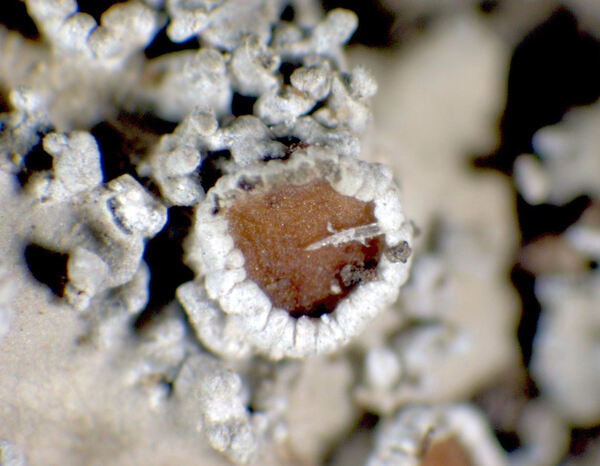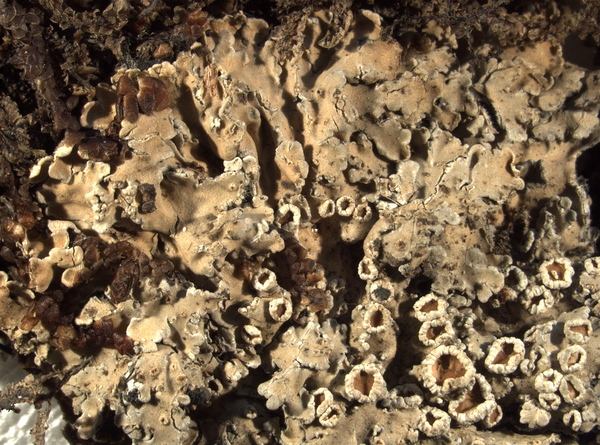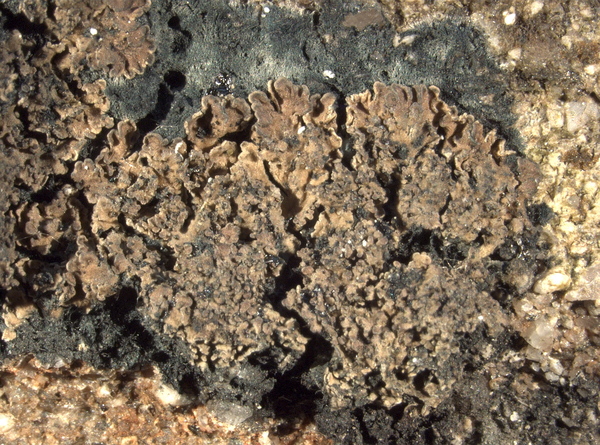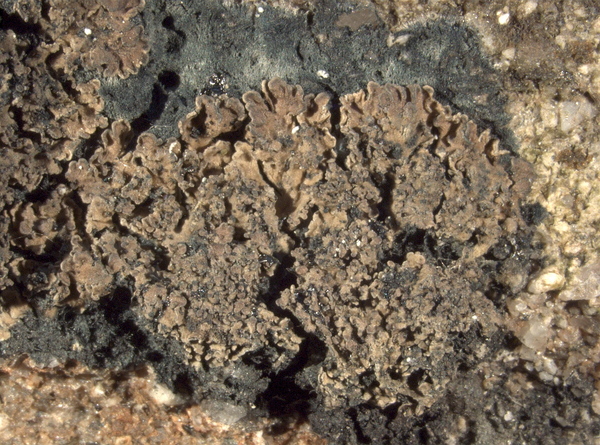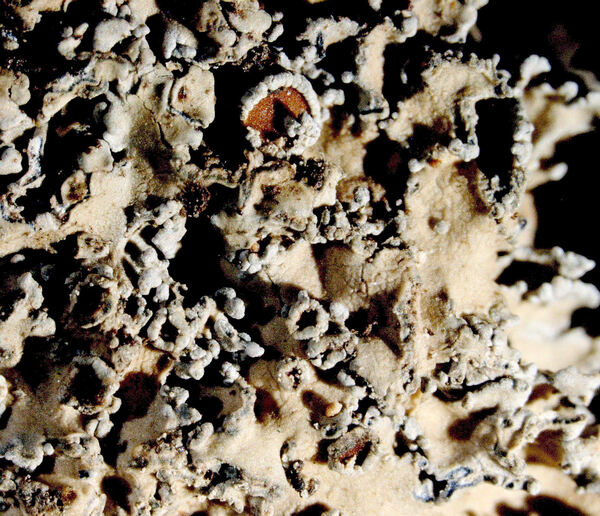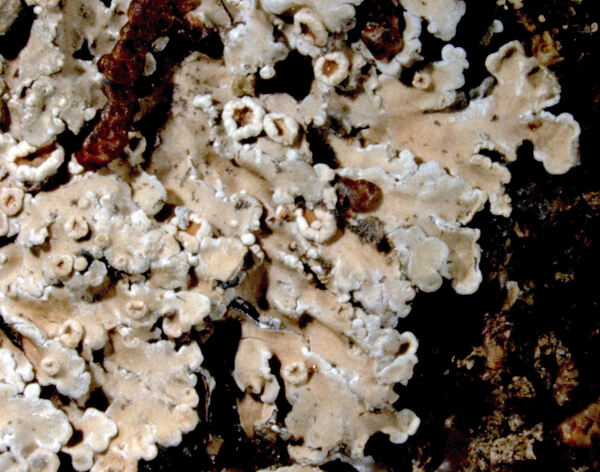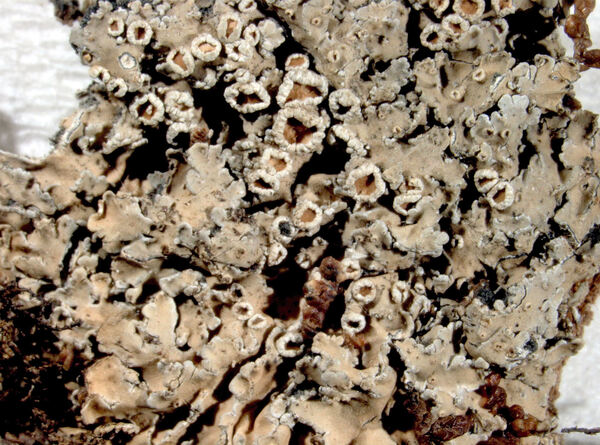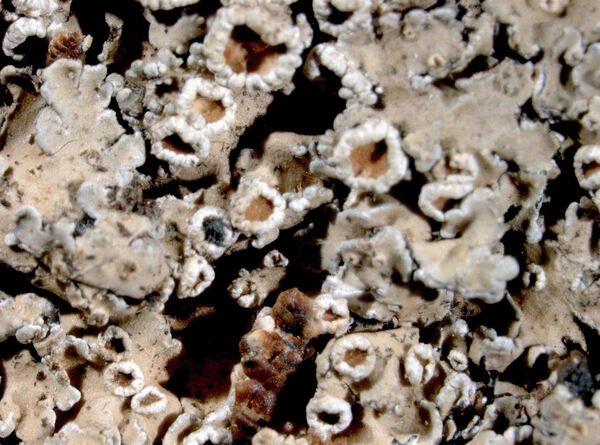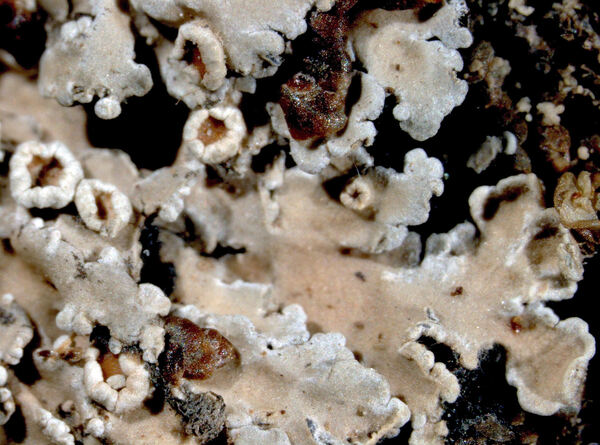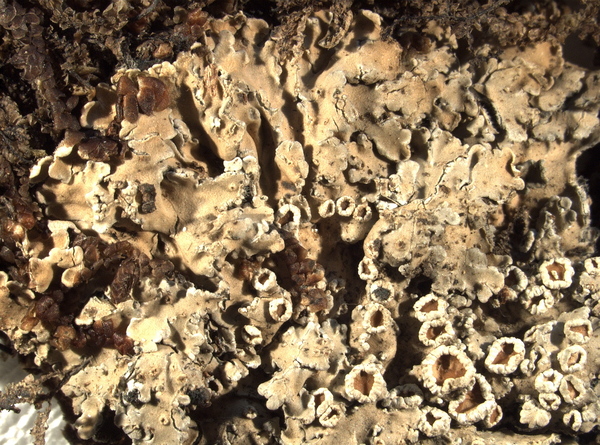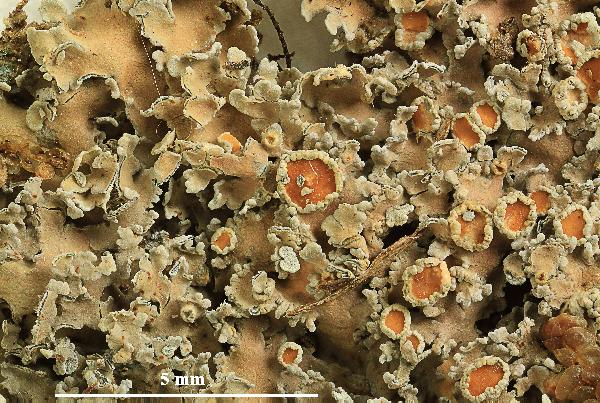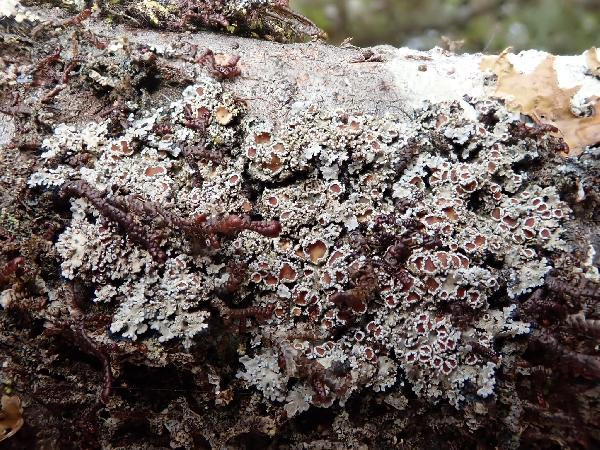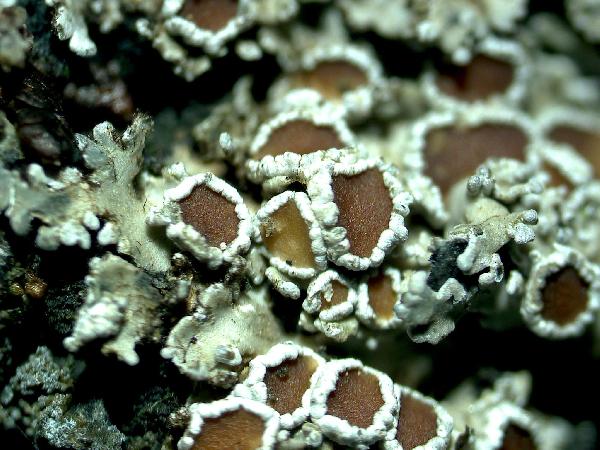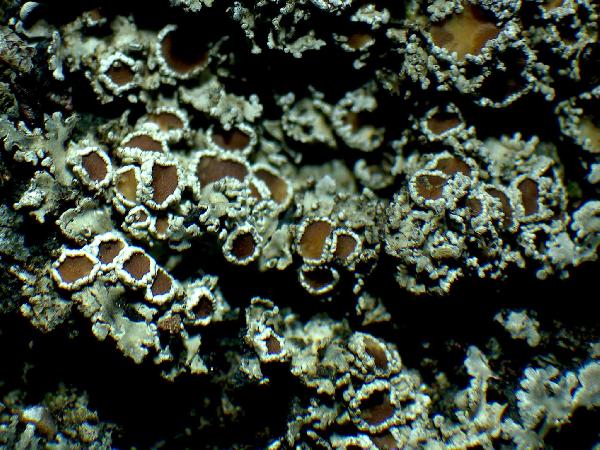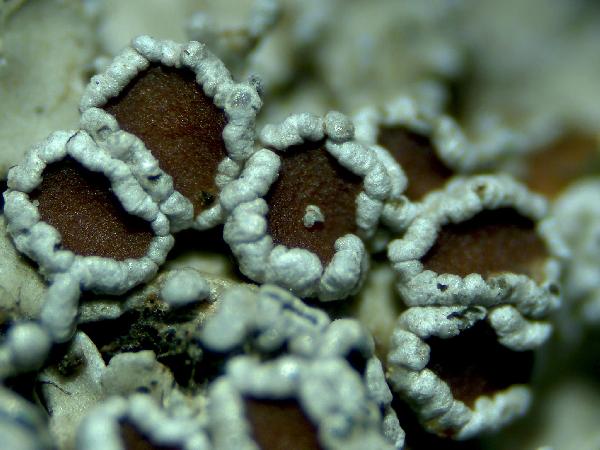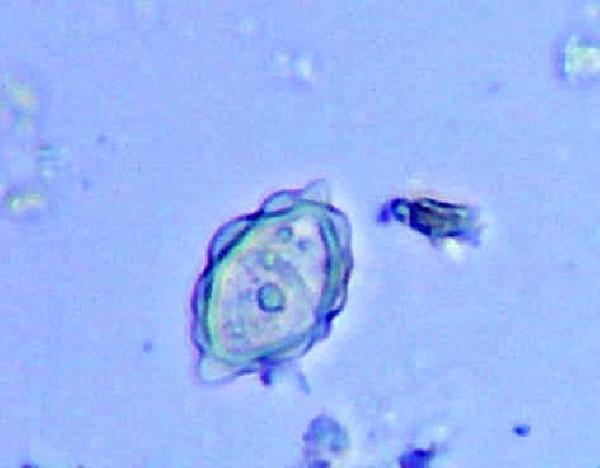Pannaria tavaresii P.M. Jørg.
Opera Bot., 45: 68, 1978.
Synonyms: Pannaria rubiginosa f. isidiosa Tav.
Distribution: N - Emil (Tretiach & al. 2008, Fariselli & al. 2020). C - Sar. S - Cal (Puntillo 1996).
Description: Thallus small-foliose, isidiate, forming up to 3 cm wide, orbicular rosettes developing on a black hypothallus which sometimes extends beyond the margins. Lobes contiguous, concave with raised margins, 3-4 mm wide and up 8 mm long, whitish or bluish grey to partly pale brown, scabrid or slightly pruinose, with granular to coralloid, mainly marginal, sometimes black-tipped isidia. Upper cortex paraplectenchymatous, 40-50 µm thick; medulla white; lower cortex absent. Apothecia lecanorine, up to 1 mm across, with a red-brown disc and a thick, often crenulate, sometimes isidiate thalline margin. Proper exciple subparaplectenchymatous, 30-40 µm thick; epithecium brownish; hymenium colourless, 100-150 µm high, I+ blue near the asci; paraphyses mostly simple, the apical cells hardly swollen; hypothecium colourless. Asci 8-spored, clavate to subcylindrical, with a well developed, non-amyloid or very weakly amyloid tholus lacking internal structures, and an intensely amyloid, thin outer sheath. Ascospores 1-celled, hyaline, ellipsoid, measuring 20-24 x 10-12 µm with epispore; 15-19 x 9-10 µm without epispore. Photobiont cyanobacterial (Nostoc, the cells in clusters). Spot tests: thallus K-, C-, KC-, P+ orange. Chemistry: pannarin.Note: a rare epiphytic species with a mainly southwestern distribution in Europe, restricted to Lobarion-communities in humid forests. It is included in the Italian red list of epiphytic lichens as “Vulnerable” (Nascimbene & al. 2013c).
Growth form: Squamulose
Substrata: bark
Photobiont: cyanobacteria, filamentous (e.g. Nostoc, Scytonema)
Reproductive strategy: mainly asexual, by soredia, or soredia-like structures (e.g. blastidia)
Restricted to humid-warm, oceanic areas
Commonnes-rarity: (info)
Alpine belt: absent
Subalpine belt: absent
Oromediterranean belt: absent
Montane belt: extremely rare
Submediterranean belt: absent
Padanian area: absent
Humid submediterranean belt: extremely rare
Humid mediterranean belt: extremely rare
Dry mediterranean belt: absent

Predictive model
Herbarium samples
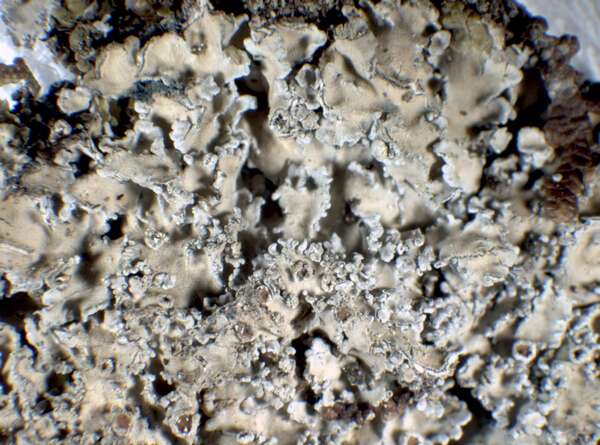

P.L. Nimis; Owner: Department of Life Sciences, University of Trieste
Herbarium: TSB (19734)
2001/11/28
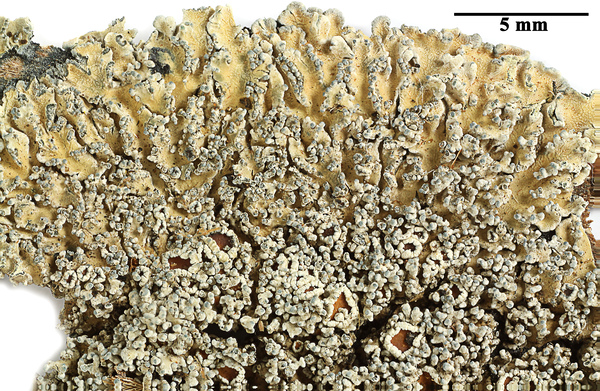

Felix Schumm CC BY-SA 4.0
[8630], PORTUGAL, MADEIRA: an der Straße bei Portela, 32°44.812’ N, 16°49.623’ W, 575 m, an Zeder. Leg. F. Schumm, 15.04.2001 (13), conf. P.M. Jorgensen 2008
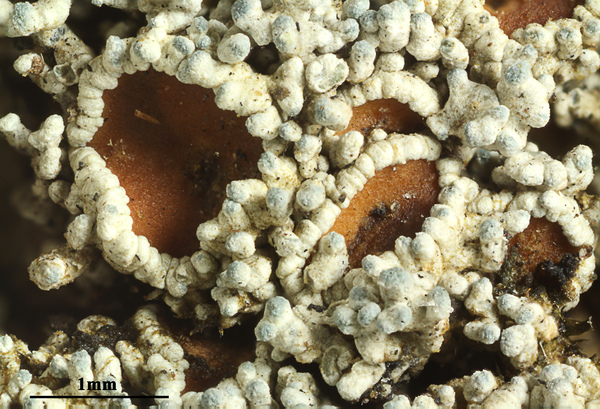

Felix Schumm CC BY-SA 4.0
[8630], PORTUGAL, MADEIRA: an der Straße bei Portela, 32°44.812’ N, 16°49.623’ W, 575 m, an Zeder. Leg. F. Schumm, 15.04.2001 (13), conf. P.M. Jorgensen 2008
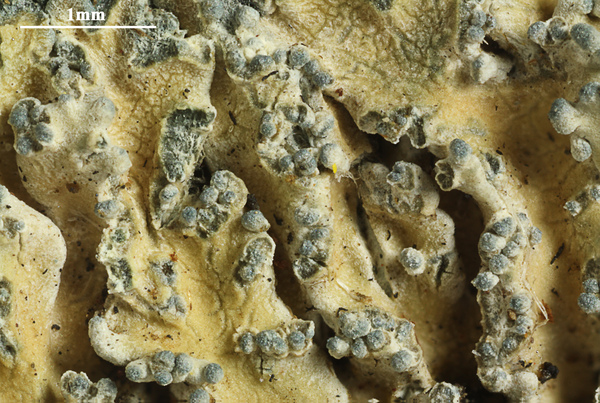

Felix Schumm CC BY-SA 4.0
[8630], PORTUGAL, MADEIRA: an der Straße bei Portela, 32°44.812’ N, 16°49.623’ W, 575 m, an Zeder. Leg. F. Schumm, 15.04.2001 (13), conf. P.M. Jorgensen 2008
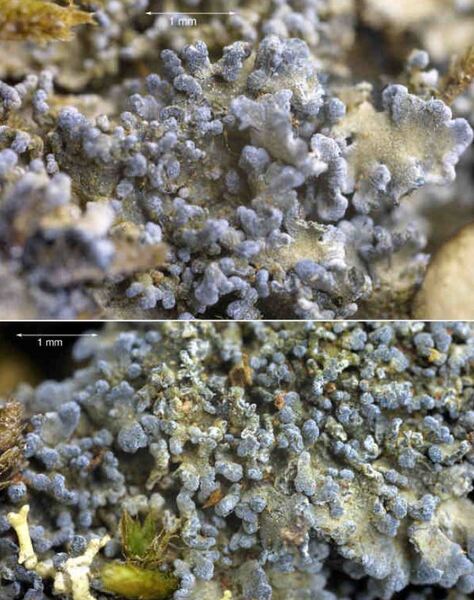

Felix Schumm – CC BY-SA 4.0
Image from: F. Schumm (2008) - Flechten Madeiras, der Kanaren und Azoren. Beck, OHG - ISBN: 978-3-00-023700-3

Ulrich Kirschbaum CC BY-SA 4.0 - Source: https://www.thm.de/lse/ulrich-kirschbaum/flechtenbilder
Spain; Canary Islands; La Gomera. (700 m) on volcanic rock
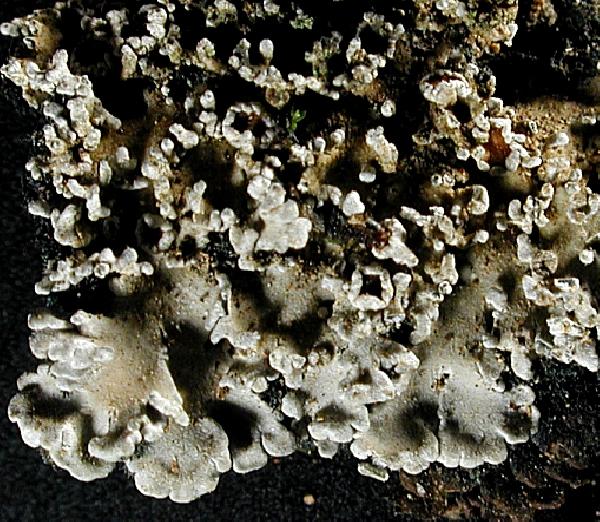
Ulrich Kirschbaum CC BY-SA 4.0 - Source: https://www.thm.de/lse/ulrich-kirschbaum/flechtenbilder
Spain; Canary Islands; La Gomera. (700 m) on volcanic rock


Felix Schumm - CC BY-SA 4.0
[ABL27945], Brazil, Santa Catarina, São Francisco do Sul, S of Prainha.
26°14'06'' S, 48°30'05'' W, 10 m. On coastal granite. Leg. M.
Cáceres & A. Aptroot (no 27945), 8 October 2015, det. A. Aptroot
2015.


Felix Schumm - CC BY-SA 4.0
[ABL27945], Brazil, Santa Catarina, São Francisco do Sul, S of Prainha.
26°14'06'' S, 48°30'05'' W, 10 m. On coastal granite. Leg. M.
Cáceres & A. Aptroot (no 27945), 8 October 2015, det. A. Aptroot
2015.
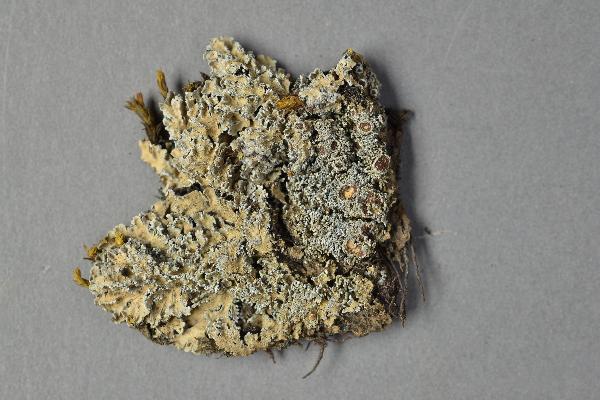
Source: https://nhm2.uio.no/typephotos/lichens/arkiv/O-L-000764d.jpg
U.S.A., COLORADO, LARIMER CO.: Larimer Co.: Loveland Heights, 1953.07.26, Dahl, E. - HOLOTYPE
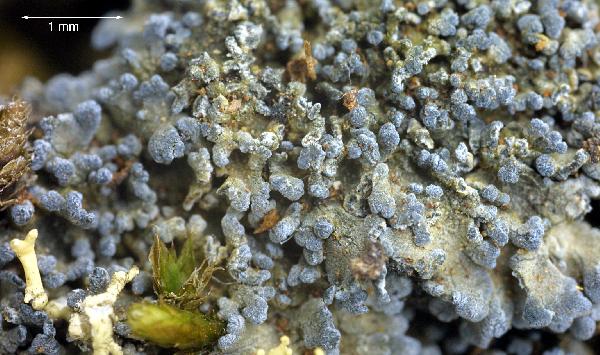

Felix Schumm - CC BY-SA 4.0
[10169], Spanien, Kanarische Inseln, La Gomera: westlich von San
Sebastian nicht weit vor der Abzweigung nach Playa Santiago.
28°05.744' N, 17°10.290' W, 840 m; Basaltblöcke in einem reich mit
Kleinia bewachsenen SO-Abhanges; licht-, wind-, nebeloffen (Viel
Ramalina/Roccella). Leg. F. Schumm, 17.04.2003, det. F. Schumm
2004, conf. P. M. Jørgensen, 2007. - P+ orange,


Felix Schumm - CC BY-SA 4.0
[10169], Spanien, Kanarische Inseln, La Gomera: westlich von San
Sebastian nicht weit vor der Abzweigung nach Playa Santiago.
28°05.744' N, 17°10.290' W, 840 m; Basaltblöcke in einem reich mit
Kleinia bewachsenen SO-Abhanges; licht-, wind-, nebeloffen (Viel
Ramalina/Roccella). Leg. F. Schumm, 17.04.2003, det. F. Schumm
2004, conf. P. M. Jørgensen, 2007. - P+ orange,
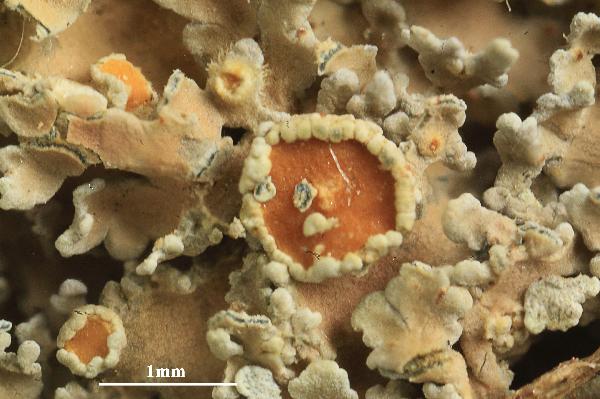

Felix Schumm - CC BY-SA 4.0
[VZR133], Insulae Canarienses, Tenerife, Montañas de Anaga, Pico de
Inglés, 900 m. Ad truncos arborum in Laurisilva. Leg. F. Ceni, A.
V zda, 9.3.1994, det. A. V zda. EX A. V ZDA: LICHENES RARIORES
EXSICCATI NR. 133.
Growth form: Squamulose
Substrata: bark
Photobiont: cyanobacteria, filamentous (e.g. Nostoc, Scytonema)
Reproductive strategy: mainly asexual, by soredia, or soredia-like structures (e.g. blastidia)
Restricted to humid-warm, oceanic areas
Commonnes-rarity: (info)
Alpine belt: absent
Subalpine belt: absent
Oromediterranean belt: absent
Montane belt: extremely rare
Submediterranean belt: absent
Padanian area: absent
Humid submediterranean belt: extremely rare
Humid mediterranean belt: extremely rare
Dry mediterranean belt: absent

Predictive model
| Herbarium samples |


P.L. Nimis; Owner: Department of Life Sciences, University of Trieste
Herbarium: TSB (19734)
2001/11/28


Felix Schumm CC BY-SA 4.0
[8630], PORTUGAL, MADEIRA: an der Straße bei Portela, 32°44.812’ N, 16°49.623’ W, 575 m, an Zeder. Leg. F. Schumm, 15.04.2001 (13), conf. P.M. Jorgensen 2008


Felix Schumm CC BY-SA 4.0
[8630], PORTUGAL, MADEIRA: an der Straße bei Portela, 32°44.812’ N, 16°49.623’ W, 575 m, an Zeder. Leg. F. Schumm, 15.04.2001 (13), conf. P.M. Jorgensen 2008


Felix Schumm CC BY-SA 4.0
[8630], PORTUGAL, MADEIRA: an der Straße bei Portela, 32°44.812’ N, 16°49.623’ W, 575 m, an Zeder. Leg. F. Schumm, 15.04.2001 (13), conf. P.M. Jorgensen 2008


Felix Schumm – CC BY-SA 4.0
Image from: F. Schumm (2008) - Flechten Madeiras, der Kanaren und Azoren. Beck, OHG - ISBN: 978-3-00-023700-3

Ulrich Kirschbaum CC BY-SA 4.0 - Source: https://www.thm.de/lse/ulrich-kirschbaum/flechtenbilder
Spain; Canary Islands; La Gomera. (700 m) on volcanic rock

Ulrich Kirschbaum CC BY-SA 4.0 - Source: https://www.thm.de/lse/ulrich-kirschbaum/flechtenbilder
Spain; Canary Islands; La Gomera. (700 m) on volcanic rock


Felix Schumm - CC BY-SA 4.0
[ABL27945], Brazil, Santa Catarina, São Francisco do Sul, S of Prainha. 26°14'06'' S, 48°30'05'' W, 10 m. On coastal granite. Leg. M. Cáceres & A. Aptroot (no 27945), 8 October 2015, det. A. Aptroot 2015.


Felix Schumm - CC BY-SA 4.0
[ABL27945], Brazil, Santa Catarina, São Francisco do Sul, S of Prainha. 26°14'06'' S, 48°30'05'' W, 10 m. On coastal granite. Leg. M. Cáceres & A. Aptroot (no 27945), 8 October 2015, det. A. Aptroot 2015.

Source: https://nhm2.uio.no/typephotos/lichens/arkiv/O-L-000764d.jpg
U.S.A., COLORADO, LARIMER CO.: Larimer Co.: Loveland Heights, 1953.07.26, Dahl, E. - HOLOTYPE


Felix Schumm - CC BY-SA 4.0
[10169], Spanien, Kanarische Inseln, La Gomera: westlich von San Sebastian nicht weit vor der Abzweigung nach Playa Santiago. 28°05.744' N, 17°10.290' W, 840 m; Basaltblöcke in einem reich mit Kleinia bewachsenen SO-Abhanges; licht-, wind-, nebeloffen (Viel Ramalina/Roccella). Leg. F. Schumm, 17.04.2003, det. F. Schumm 2004, conf. P. M. Jørgensen, 2007. - P+ orange,


Felix Schumm - CC BY-SA 4.0
[10169], Spanien, Kanarische Inseln, La Gomera: westlich von San Sebastian nicht weit vor der Abzweigung nach Playa Santiago. 28°05.744' N, 17°10.290' W, 840 m; Basaltblöcke in einem reich mit Kleinia bewachsenen SO-Abhanges; licht-, wind-, nebeloffen (Viel Ramalina/Roccella). Leg. F. Schumm, 17.04.2003, det. F. Schumm 2004, conf. P. M. Jørgensen, 2007. - P+ orange,


 Index Fungorum
Index Fungorum
 GBIF
GBIF
